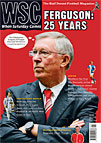 Ron Hamilton asks where next for Darlington, as they endure another woeful season
Ron Hamilton asks where next for Darlington, as they endure another woeful season
Supporting Darlington has long had a certain Beckettian quality – an unceasing bleakness punctuated by bursts of farcical tragicomedy. Even in the aftermath of May’s FA Trophy victory, the joy of a winner in the 120th minute at Wembley soon gave way to cynical muttering about how long it would be before things went wrong. Less than six months later the club’s future is, once again, hanging in the balance.
A humiliating FA Cup defeat at Hinckley on November 1 – the latest in a long-running series of “new lows” – came days after Mark Cooper had been sacked and left the club seeking a seventh manager in three years. Chairman Raj Singh then announced that he was tired of pumping £80,000 a month into the club and threatened to pull the plug. Singh claimed he would only be dissuaded if the players accepting a wage cut and the local c ouncil submitted to his demand to waive the covenant which ensures 75 per cent of all non-football profit goes to them. Eight players abruptly left, and more are to follow. The council rejected Singh’s request out of hand, leaving the pair effectively daring each other to deliver the coup de grâce.
As the stand-off progressed, thoughts turned to how the club yet again found itself in such a predicament. The seeds were sown earlier this year, when major creditors Scott & Sizer called in their £1.7 million loan and assumed ownership of the stadium and, more crucially, the surrounding land. Singh, as now, threatened to walk – a short-term crisis that distracted from the sense that the club was only being kept alive to facilitate future profits from a land sale. The loan continued to accrue at 12 per cent, meaning the annual rent of £10,000 for the use of the stadium pales next to the £200,000 a year interest that continues to sap the club’s finances.
Even this tells only half the story. Despite his unedifying efforts to cast the council as the intransigent villains of the piece, Singh is seen by many as a decent man swimming hopelessly against the tide. The council, meanwhile, can cite their duty to the taxpayer at a time when their budget is being slashed as reason to maintain the covenant. Even Scott & Sizer can justifiably claim a desire to protect an investment made in good faith. With the chief suspects eliminated, where does blame really lie? Peel back the layers of argument, the vested interests and financial brinksmanship and what remains is Darlington’s risible home, the Arena. As with so much of the club’s recent woe, all roads lead to George Reynolds.
Former owner Reynolds, for those fortunate enough to have forgotten, was the safe-cracker turned chipboard magnate who had delusions of grandeur and an ear for crowd-pleasing soundbites. He was the man who arbitrarily decided to build the 25,000-capacity ground that he saw as his glorious legacy. Instead, the stadium, with “escalators and toilets that would make Real Madrid jealous”, has become a freakshow exhibit for opposition fans, who come to ogle at the oversized hulk. The direct cause of two spells in administration and a permanent state of financial strife – the death by a thousand cuts that has roundly disenfranchised fans and townspeople alike – the Arena is the millstone that continues to drag the club down.
So what of the future? The club continue to stumble on while Singh’s finger wavers over the detonate button. The squad is stripped bare, the appointment of a new manager is a distant proposition and morale is through the floor. Even the type of optimist rare in this corner of County Durham would struggle to predict anything other than a long slog to avoid relegation to the Blue Square North.
More likely is another spell in administration, or worse. The club, barely sustainable in the Football League and even less so now, has a large outstanding debt, no tangible assets and a labyrinthine tangle of covenants, loans and creditors around an unpopular and unprofitable home. After remarkable efforts to keep the club afloat in the past, fans are exhausted by the constant effort to plug each new leak and increasingly contemplating letting the roof fall in. The only hope for the club to become viable again is to move, and there is a tacit acceptance that the best way to achieve this may be to start again from scratch. As heartbreaking as it is to admit, staring into the abyss has never seemed a more attractive proposition.
From WSC 299 January 2012